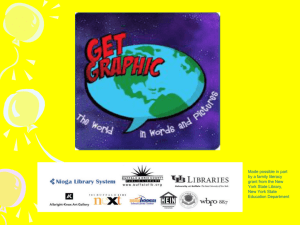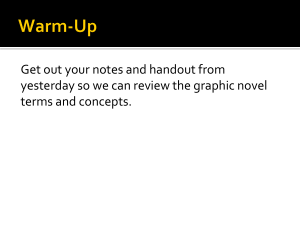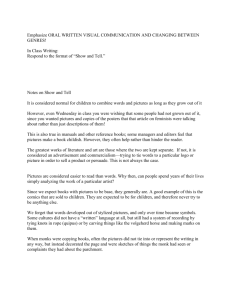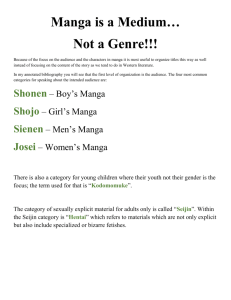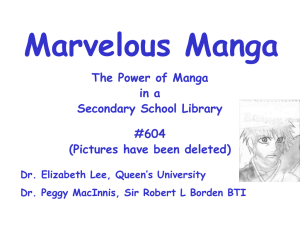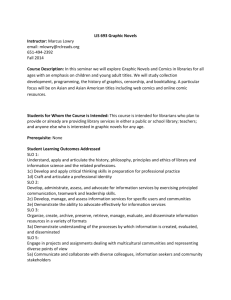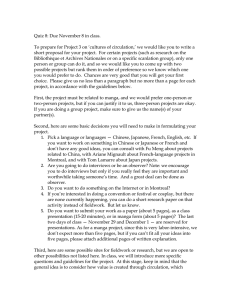NYLA Graphic Novels Powerpoint Presentation
advertisement
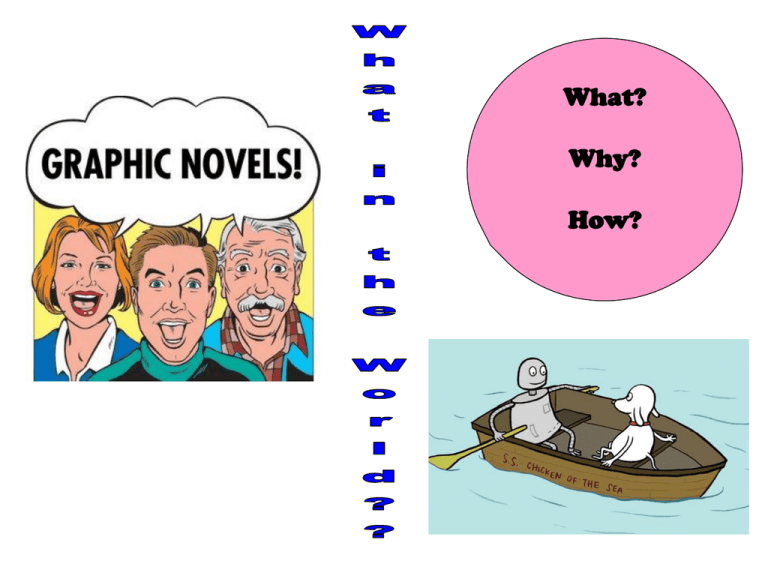
What? Why? How? • Same format as comic books • Text & illustrations present information • Medium, not genre • Book-length, usually contain one story A Graphic Novel Page Pages consist of a variety of elements • Panels-squares or rectangles that contain a single scene • Gutters-space between panels • Dialog Balloons-contain communication between/among characters • Thought Balloons-contain a character’s thoughts • Captions-contain information about a scene or character • Sound Effects-visual sound clues i.e.. Wonk! Pow! How to Read a Graphic Novel Page Graphic novels are read left to right, just like traditional texts Dialog Balloons dialog balloons are read left to right or top to bottom as is appropriate. 1 4 2 3 5 Sometimes it can get a little more complicated… 2 1 But the basic left to right rule still applies to panels 3 4 2 1 and dialog balloons as well 3 4 5 6 7 Major Types Humor Non-Fiction Fantasies Adaptations or Spin-offs Realistic Fiction Personal Stories Toon Books • For age 4+ • Can be read to or by children • Vetted by educators Manga • Manga=comic books • Period before WWII=beginning of modern manga How to read a Manga Page Unlike traditional western books, Manga is read right-to-left and “back” to “front” Often, if you start at what looks like the front of the Manga, you will see a message like this 1 2 Panels are read right to left 3 4 5 3 2 1 4 As are dialog balloons 6 7 5 10 11 8 9 Common Manga Character Traits Large, expressive eyes Small noses Tiny mouths Types of Manga • Shonen: teenage boys • Shojo: teenage girls • Shonen-ai / Yaoi=boys love Manga Adaptations Popular & Respected • Read by everyone • Artists & writers well respected • Much anime based on manga • perceived as subversive=attractive! • Ratings • “God of Manga” Osamu Tezuka • Hayayo Miyazaki: anime & manga Names to Know First comic “strip” • Appeared in New York World: 1895 • R. F. Outcault • Increased sales Katzenjammer Kids • 1897 • Used word balloons • Used multiple panels to tell story Early 20th Century • Windsor McCay – Chalk-talk artist – Broadway musical – Animated movie Popularity Grows • By early 1900’s, over 150 strips in syndication • 1929: Tarzan • 1931: Dick Tracy The Comic Book • 1933-reprints of comic strips • Initially free • 1935-original stories & characters • 10 cents each Popular comics • Superman – First superhero – On newsstands: 1938 • Characters spun-off into radio & movies • Superheroes big during World War II After WWII: crime, science fiction and horror comics Shades of things to come… • The Spirit published as book-type supplement • National newspapers • Educated readers 1950’s: comics in crisis! • Frederic Wertham • Comics examined by US Senate • Comics banned and burned A New Beginning • Late 1950’s: Justice League of America born • 1961: Fantastic Four, Incredible Hulk, & Spiderman • 1960’s: Self-published underground comics Milestones in the Graphic Novel World • 1978-Will Eisner coins term • 1986- Batman: the Dark Knight Returns • 1987- The Watchmen • 1992- Maus: A Survivor’s Tale wins Pulitzer • 2005-”Graphix” imprint launched • 2006- American Born Chinese named NBA finalist for Young People’s Literature • 2007- American Born Chinese wins Printz Award for excellence in YA literature • 2007 The Invention of Hugo Cabret finalist for NBA • 2008 Invention wins Caldecott • 2007-YALSA creates new annual booklist: “Great Graphic Novels for Teens” • 2009-NYT Graphic Books Bestseller List • 2009- David Small’s Stitches NBA finalist New Graphic Classics • Marvel Illustrated • IDW • Manga Shakespeare • Classical Comics Educational GNs President Obama collects both Spider-Man and Conan the Barbarian comics Why Graphic Novels & Manga? • 6.3 million secondary school students reading below grade level. • Average American age 15-24 spends only 7 minutes of daily leisure time reading. • >57%of high schoolers devote 3 or more hours of an average school day to electronic viewing. • Students with access to variety of reading materials=higher average reading scores. Graphic Novels & Manga: • Present complex material in readable text • Serve as a bridge to more difficult reading • Challenge readers of more traditional literature • Embrace nature of multimedia world • Fulfill NCTE’s “21st Century literacies” (multiple streams, simultaneous information) Checking Out Graphic Novels & Manga • Public Library • Local comic stores • Book stores Purchasing • Many traditional library suppliers offer graphic novel titles. • Local comic stores • Book stores Collection Development Policies • Clear (enough) definition • Selection criteria • Maintenance • Challenges Classification & Shelving • Within general collection • Format specific (PS, NC or 741.5) • Graphic Novel designation • DNC Learning more about Graphic Novels & Manga! Reviews & More School Library Journal Library Journal Diamond Comics Bookshelf Cooperative Children’s Book Center • Get Graphic! • Graphic Novel Resources: SUNY at Buffalo • First Second Books • Public Square Books
